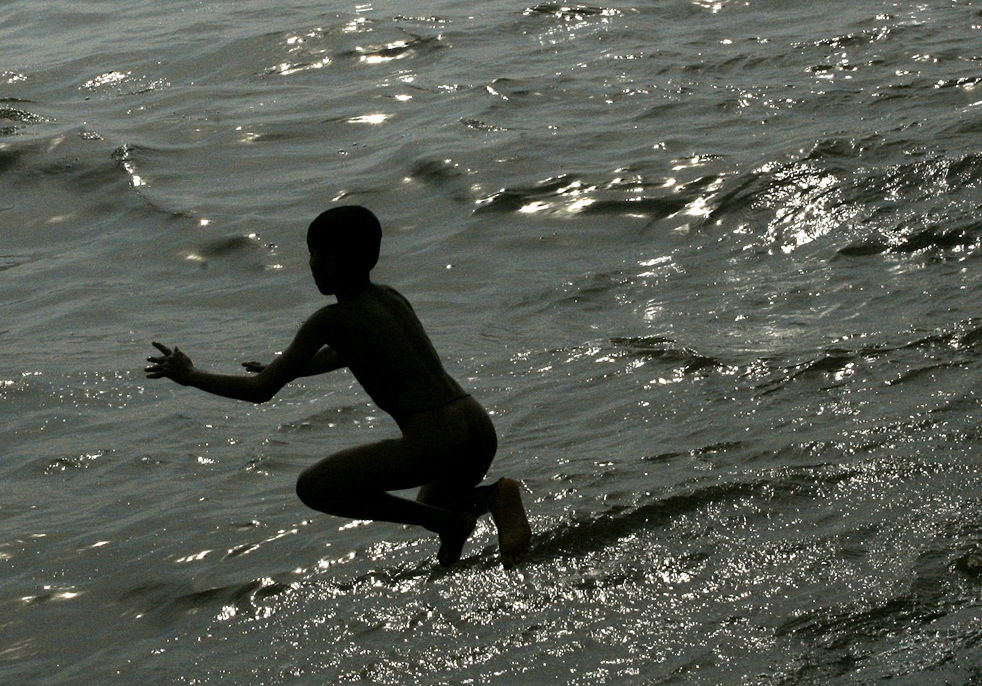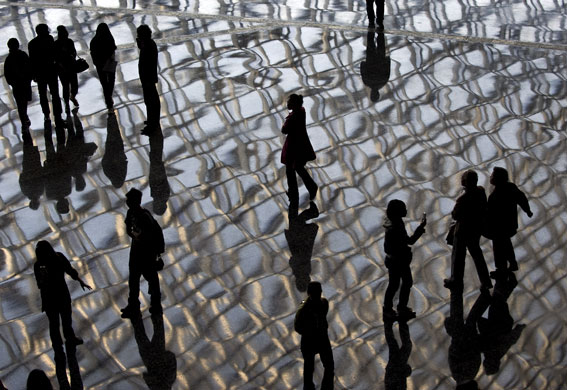One might expect a silhouette to signify some deficiency, at least of knowledge. Instead of detail, we see only darkness; instead of personality, anonymity. When life is reduced to simple cut-outs, we seem to be in the realm of craft projects, not the sensuous intelligence of art. Photography, however, can take us to a third place.

This boy has been caught in a sliver of time, just enough to isolate his youthful figure before it returns to splash and flow, all movement and delight in the water. We can see exactly the odd proportions that characterize the child’s body, and the awkward awareness of that body in space–something that will be completely dissolved as he enters the water.
Reducing the individual boy to an outline seems to essentialize something–the human form, perhaps, and, more likely, Childhood. Thus the image reminds us that, whatever is there, is fleeting. Likewise, although the hard surface of the water will return to liquid, that igneous surface reveals another reality beneath his simple pleasure. Enjoy the moment, kid, because soon enough the world won’t be so giving. The mood is nostalgic, and with that, all too conventional.
No visual technique need have a single emotional effect, and adulthood is more than the loss of innocence. This second photograph suggests another, very different experience.

Visitors stroll around the National Grand Theatre in Bejiing. Here even silhouettes have silhouettes. The ground appears to be something like a fun-house mirror, and yet the shadows are as crisp as the standing figures. As above, motion as been arrested, but here many small details suggest continual movement as each individual projects a specific inclination. The various groupings tells us that we are in a public space, one where individuals go their varied ways, small groups congregate for varied purposes, and everyone is comfortable enough among strangers. Again, the silhouette reveals something fundamental about both a place and a time of life, or, perhaps, an historical period. The mood, which comes from both figures and ground, is at once peaceful and agitated, like the modern civil society that it mirrors. And whereas the first photograph made water appear like rock, this photo suggests that the ground itself can melt like ice cubes in a world where all that is solid melts into air.
Silhouettes depend on darkness, but these photographs are distinguished also by the play of light. Each can prompt meditation in either direction: toward a more pessimistic or a more optimistic end. I guess I’m feeling optimistic today. If the first image captures a state of nature and the joy of childhood, the second suggests that there is something luminous about adult life in a modern society as well. If that is so, the better images will be those that help us see, not the outline, but the form.
Photographs by Rajanish Kakade/Associated Press and Andy Wong/Associated Press. You can see other posts at NCN on silhouettes by using the search function in the right sidebar. The light in the images is today is silver, but the title of the post continues a theme also expressed with gold.
Scott McCloud talks about abstraction in Understanding Comics – for him, reducing an image to something less detailed than what would be considered “photo-real” (as in a cartoon or in the above silhouettes) universalizes the subject of the image. In the photo above, for example, we see not an image of a particular child, but a representation of an abstract idea of “child-ness”. The image becomes a signifier for a broader class of referents, which allows it to have a more powerful (or at least farther reaching) effect, since it is easier for the audience to relate to.
Your pairing of these photographs calls to mind a very similar pairing: Cartier-Bresson’s “Behind the Gare St. Lazare” and Munkacsi’s “Three Boys at Lake Tanganyika,” both from the 1930s (see them here: http://www.preoccupations.org/2004/08/cartierbresson__1.html)
I am struck by how these pairings speak to many shared themes (silhouettes vs. shadows, youth vs. adult, nature vs. city, leisure vs. work, etc.) in a visual language that indeed suggests optimism, at least for the enduring power of photography to comment on the human condition. Maybe it is the very outlines and shadows of the human body, working almost as puzzle pieces missing from a giant composition, which invite us, the viewers, to engage with the photograph and see beyond the darkness to see ourselves.